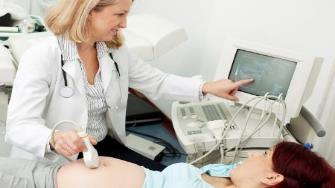MRI Technician vs Ultrasound Technician
Radiology offers career choices working with magnetic resonance imaging, ultrasound, and sonography.

Radiology is the science of taking images of the human body for medical diagnostic purposes. There are many different types of x-rays, most of which use ionizing radiation that exposes a patient to its harmful effects.
There are two other radiology choices that use other means to more safely take diagnostic images -- magnetic resonance imaging (MRI) and ultrasound or sonography. In certain situations, one or both of these tests is the appropriate choice for an accurate medical diagnosis.
It is important to understand the basis of each diagnostic study:
Magnetic Resonance Imaging (MRI)
MRI uses a strong magnetic field to create detailed images of body structures. It is especially helpful to detect diseases in the brain, spine and bones. The patient is inserted in a large open-ended chamber that creates a magnetic field. This, in turn, disturbs the magnetic field in the body, which helps to produce a diagnostic image.
Ultrasound or Sonography
Ultrasound uses high frequency sound waves to create images. The sound waves are emitted and received by a hand-held transducer as they bounce off the body cavity being evaluated. It is a good diagnostic tool for the nervous and digestive system, and to check the status of an unborn baby.
Compare and Contrast the Career Choices
A popular allied health profession career choice is that of an MRI technician or an ultrasound technician. Which will it be?
Education
Both professions usually begin their career with an associate’s degree from an accredited college program. There are also colleges and universities that offer a bachelor’s degree in diagnostic imaging with a concentration in MRI or sonography. The educational process includes classroom time for the basic sciences plus instruction and practical experience with the diagnostic equipment in a clinical setting.
Certification to demonstrate expertise in the specific field is available and recommended through the American Registry of Radiologic Technologists, the American Registry for Diagnostic Medical Sonography and the American Medical Technologists.
Most states require radiologic technologists to be licensed, regardless of the specialty.
Duties
Both technologists are charged with the responsibility of maintaining and operating the diagnostic equipment, patient teaching about the procedure and properly positioning and securing the patient for the test.
MRI technicians have an additional clinical duty. They are also responsible for protecting the patient from the magnetic field within the scanner. All jewelry must be removed and implanted devices, especially those in or around the heart, must be identified. Patients with implanted devices cannot safely have an MRI. For some MRI procedures, the technician might also inject the patient with a paramagnetic material.
Salary
According to the American Society of Radiologic Technologists, the average salary for an MRI technologist is $65,099 and an ultrasound technologist is $68,821.
Job Outlook
Currently, the demand for both radiology technologists is high and expected to remain in demand. Who wins? The Bureau of Labor Statistics projects these numbers over a ten-year period:
- Radiologic technologists, a division that includes MRI technologists, will experience a 28% rate of job growth
- Sonographers are projected to experience a 44% rate of job growth
Both technicians work under the direction of a physician and/or department manager. The quality and accuracy of both MRI and ultrasound diagnostic tests are critical to the appropriate medical care for the patient population.
Either allied health career choice, MRI or ultrasound technologist, is a good one. It is a matter of personal medical interests. The choice is yours to make.

